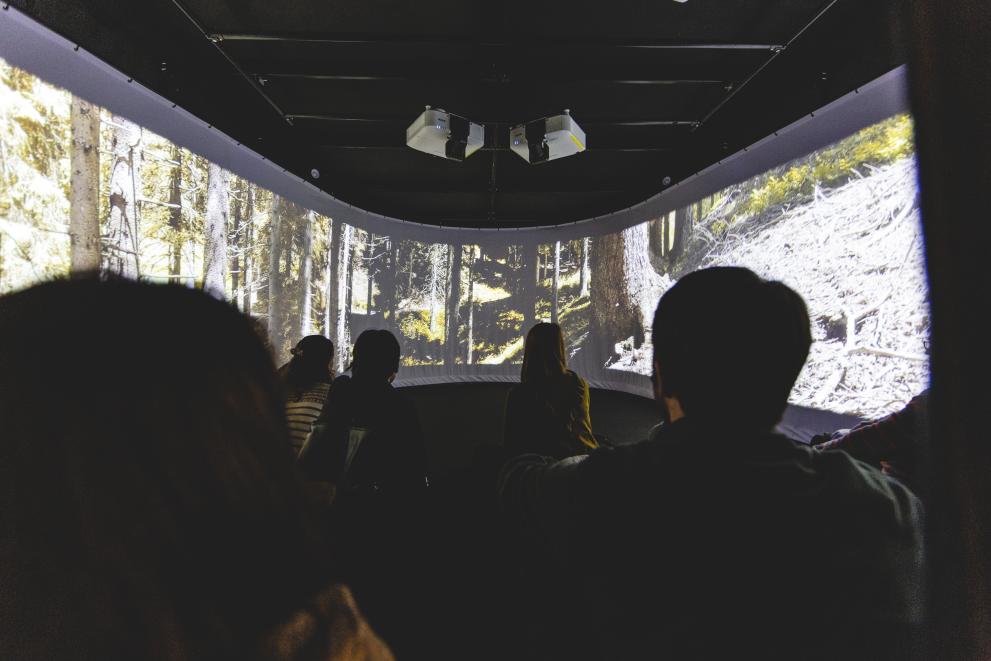
Implementation: November 2022 - September 2023
Member state: Italy
Contact organisation: MUSE, Museo delle Scienze, Trento
Contact: info lifewolfalps [dot] eu (info[at]lifewolfalps[dot]eu)
lifewolfalps [dot] eu (info[at]lifewolfalps[dot]eu)
More information: https://www.lifewolfalps.eu/en/nella-mente-del-lupo/
Target species: Wolf
Introduction:
Communication on large carnivores is often focused around conflict and addressing those who are strongly opposed to large carnivore presence. This however risks losing the broader public who perhaps have less strong feelings around large carnivore presence but have the potential to be interested by their biology and behaviour. As part of the EU LIFE WolfAlps project, this public is addressed through a range of actions. One innovative approach is collaboration with artists and museums. The project has designed and presented an immersive exhibition using video and audio effects, which tries to see coexistence from the perspective of a young wolf in dispersal (leaving his home pack to find a new territory and mate). The exhibition was hosted at Muse from 4 November to 28 May, then travelled to the St. Francis Monumental Complex in Cuneo (10/06/2023 - 2/09/2023) .The openings of the exhibition where both times preceded by an educational event where speeches on coexistence, study and prevention of threats to conservation where held. Both openings also included a dialogue with Italy’s leading wolf expert Luigi Boitani. From September till October, the exhibition moved to Milan. In all locations, the exhibition was complemented by conferences on wolves, activities for children, teacher’s training, and in Cuneo also bicycle excursions including a visit to the Centre for People and Wolves.
Key actions:
- Research on similar types of immersive exhibitions and the techniques used
- Development of a script for the exhibition, assisted by researchers and communicators of the LIFE WolfsAlps EU project
- Video footage was filmed in Trentino
- Development of audio visuals with input from the contracted company Filmwork, supervised by MUSE.
- Exhibition trialled and adapted according to feedback, original ideas had to be scaled back due to costs and the technologies adapted as the immersive video affected some participants physically (motion sickness).
- Opening of the exhibition was preceded a dialogue with the wolf expert Luigi Boitani, discussing biology of wolves as well as protection laws and coexistence in Italy
- Didactic activities and teacher trainings accompanying the exhibition e.g. "The wolf between legend and reality"
- All conferences on wolf topic organized during the exhibition went sold out and people enjoyed it
- the exhibition was an opportunity to promote the project
- Journalists invited to the press conference had the opportunity to learn about wolf biology
Results:
The approach, examining coexistence from the perspectives of the challenges faced by an animal trying to adapt to a manmade environment and keeping hidden from human view has not been widely trialled. Many visitors reported that they felt more compassionate toward the wolf experiencing this video, although the video in itself has no dialogue or comments. This means that images and immersive broadcast can reach emotion and make people thinking from a different perspective.
The experimental exhibition also reached people that are not interested in wolves, but are attracted by art and technologies. The opening attracted journalists, and created opportunities for experts to disseminate information on wolf biology and coexistence.
The exhibition was visited by 51,000 people in 3 different locations.
Financing:
The project was funded through the EU LIFE WolfAlps project. To set up the exhibition cost 35,000 euro VAT excluded the touring cost 20,000 euro VAT excluded. It is important to mention that Muse had already the technologies required for the exhibition and borrowed them with an agreement to project partners. Three video projectors were used at a cost per projection lens of 6000 euros. The Watchout (a software needed for a multiscreen projection) cost about 15,000 euros. It would be possible to host the exhibition at lower cost by using a completely dark room in which video projectors (fixed to the ceiling) project onto a canvas or onto semi-circular panels
Sources
Details
- Publication date
- 4 December 2023
- Author
- Directorate-General for Environment

